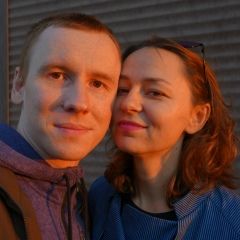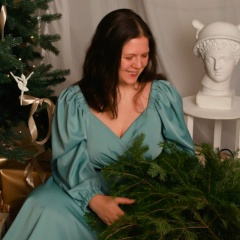В жару просыпается ностальгия по тенистой прохладе Летнего сада. Непеределанного.
И я согласна с Дмитрием Сергеевичем.
"<...>
Отношение к прошлому может быть двух родов: как к некоторому зрелищу, театру, представлению, декорации и как к документу. Первое отношение стремится воспроизвести прошлое, возродить его зрительный образ. Второе стремится сохранить прошлое хотя бы в его частичных остатках. Для первого в садово-парковом искусстве важно воссоздать внешний, зрительный образ парка или сада таким, каким его видели в тот или иной момент его жизни. Для второго важно ощутить свидетельство времени, важна документальность. Первое говорит: таким он выглядел; второе свидетельствует: это ТОТ самый, он был, может быть, не таким, но это подлинно ТОТ, это ТЕ липы, ТЕ садовые строения, ТЕ самые скульптуры. Второе отношение терпимее к первому, чем первое ко второму. Первое отношение к прошлому требует вырубить в аллее старые деревья и насадить новые: "так аллея выглядела". Второе отношение сложнее: сохранить все старые деревья, продлить им жизнь и подсадить к ним на места погибших молодые. Две-три старые дуплистые липы среди сотни молодых будут свидетельствовать: это та самая аллея — вот они, старожилы. А о молодых деревьях не надо заботиться: они растут быстро и скоро аллея приобретет прежний вид.
Но в двух отношениях к прошлому есть и еще одно существенное различие. Первое будет требовать: только одна эпоха — эпоха создания парка, или его расцвета, или чем-либо знаменательная. Второе скажет: пусть живут все эпохи, так или иначе знаменательные, ценна вся жизнь парка целиком, ценны воспоминания о различных эпохах и о различных поэтах, воспевших эти места, — и от реставрации потребует не восстановления, а сохранения. Первое отношение к паркам и садам открыл в России Александр Бенуа с его эстетским культом времени императрицы Елизаветы Петровны и ее Екатерининского парка в Царском Селе. С ним поэтически полемизировала Ахматова, для которой в Царском был важен Пушкин, а не Елизавета: «3десь лежала ЕГО треуголка и растрепанный том Парни».
Да, вы поняли меня правильно: я на стороне второго отношения к памятникам прошлого. И не только потому, что второе отношение шире, терпимее и осторожнее, менее самоуверенно и оставляет больше природе, заставляя уважительно отступать внимательного человека, но и потому еще, что оно требует от человека большего воображения, большей творческой активности. Восприятие памятника искусства только тогда полноценно, когда оно мысленно воссоздает, творит вместе с творцом, исполнено историческими ассоциациями.
Первое отношение к прошлому создает, в общем-то, учебные пособия, учебные макеты: смотрите и знайте. Второе отношение к прошлому требует правды, аналитической способности: надо отделить возраст от объекта, надо вообразить, как тут было, надо в некоторой степени исследовать. Это второе отношение требует большей интеллектуальной дисциплины, больших знаний от самого зрителя: смотрите и воображайте. И это интеллектуальное отношение к памятникам прошлого рано или поздно возникает вновь и вновь. Нельзя убить подлинное прошлое и заменить его театрализованным, даже если театрализованные реконструкции уничтожили все документы, но место осталось: здесь, на этом месте, на этой почве, в этом географическом пункте, было — он был, оно, что-то памятное, произошло.
И ещё одно попутное замечание о садах. Стремиться к восстановлению садов в их первоначальном виде невозможно по одной причине: сад неразрывно связан с садовым бытом и социальным устройством общества. В Царском Села работало 400 садовников, в многочисленных оранжереях разводились редчайшие цветы, стволы деревьев мылись мылом, а для гуляний в Петергофском саду придворные обязаны были носить так называемые "петергофские платья" тёмно-зелёного цвета с серебряным шитьём. Тёмно-зелёный цвет — чтобы гармонировал с цветом деревьев, а серебро — чтобы гармонировало с белой пеною фонтанов. Имитировать первоначальный придворный облик садов без двора и дворцовых приёмов в садах — совершенно невозможно: слишком тесно был связан сад и садовый быт с классовым строением общества. <...>"
Д.С. Лихачёв "Сады и парки"
И я согласна с Дмитрием Сергеевичем.
"<...>
Отношение к прошлому может быть двух родов: как к некоторому зрелищу, театру, представлению, декорации и как к документу. Первое отношение стремится воспроизвести прошлое, возродить его зрительный образ. Второе стремится сохранить прошлое хотя бы в его частичных остатках. Для первого в садово-парковом искусстве важно воссоздать внешний, зрительный образ парка или сада таким, каким его видели в тот или иной момент его жизни. Для второго важно ощутить свидетельство времени, важна документальность. Первое говорит: таким он выглядел; второе свидетельствует: это ТОТ самый, он был, может быть, не таким, но это подлинно ТОТ, это ТЕ липы, ТЕ садовые строения, ТЕ самые скульптуры. Второе отношение терпимее к первому, чем первое ко второму. Первое отношение к прошлому требует вырубить в аллее старые деревья и насадить новые: "так аллея выглядела". Второе отношение сложнее: сохранить все старые деревья, продлить им жизнь и подсадить к ним на места погибших молодые. Две-три старые дуплистые липы среди сотни молодых будут свидетельствовать: это та самая аллея — вот они, старожилы. А о молодых деревьях не надо заботиться: они растут быстро и скоро аллея приобретет прежний вид.
Но в двух отношениях к прошлому есть и еще одно существенное различие. Первое будет требовать: только одна эпоха — эпоха создания парка, или его расцвета, или чем-либо знаменательная. Второе скажет: пусть живут все эпохи, так или иначе знаменательные, ценна вся жизнь парка целиком, ценны воспоминания о различных эпохах и о различных поэтах, воспевших эти места, — и от реставрации потребует не восстановления, а сохранения. Первое отношение к паркам и садам открыл в России Александр Бенуа с его эстетским культом времени императрицы Елизаветы Петровны и ее Екатерининского парка в Царском Селе. С ним поэтически полемизировала Ахматова, для которой в Царском был важен Пушкин, а не Елизавета: «3десь лежала ЕГО треуголка и растрепанный том Парни».
Да, вы поняли меня правильно: я на стороне второго отношения к памятникам прошлого. И не только потому, что второе отношение шире, терпимее и осторожнее, менее самоуверенно и оставляет больше природе, заставляя уважительно отступать внимательного человека, но и потому еще, что оно требует от человека большего воображения, большей творческой активности. Восприятие памятника искусства только тогда полноценно, когда оно мысленно воссоздает, творит вместе с творцом, исполнено историческими ассоциациями.
Первое отношение к прошлому создает, в общем-то, учебные пособия, учебные макеты: смотрите и знайте. Второе отношение к прошлому требует правды, аналитической способности: надо отделить возраст от объекта, надо вообразить, как тут было, надо в некоторой степени исследовать. Это второе отношение требует большей интеллектуальной дисциплины, больших знаний от самого зрителя: смотрите и воображайте. И это интеллектуальное отношение к памятникам прошлого рано или поздно возникает вновь и вновь. Нельзя убить подлинное прошлое и заменить его театрализованным, даже если театрализованные реконструкции уничтожили все документы, но место осталось: здесь, на этом месте, на этой почве, в этом географическом пункте, было — он был, оно, что-то памятное, произошло.
И ещё одно попутное замечание о садах. Стремиться к восстановлению садов в их первоначальном виде невозможно по одной причине: сад неразрывно связан с садовым бытом и социальным устройством общества. В Царском Села работало 400 садовников, в многочисленных оранжереях разводились редчайшие цветы, стволы деревьев мылись мылом, а для гуляний в Петергофском саду придворные обязаны были носить так называемые "петергофские платья" тёмно-зелёного цвета с серебряным шитьём. Тёмно-зелёный цвет — чтобы гармонировал с цветом деревьев, а серебро — чтобы гармонировало с белой пеною фонтанов. Имитировать первоначальный придворный облик садов без двора и дворцовых приёмов в садах — совершенно невозможно: слишком тесно был связан сад и садовый быт с классовым строением общества. <...>"
Д.С. Лихачёв "Сады и парки"
In the heat, nostalgia wakes up for the shady coolness of the Summer Garden. Unremade.
And I agree with Dmitry Sergeevich.
"<...>
The attitude to the past can be of two kinds: as a kind of spectacle, theater, performance, scenery, and as a document. The first relation seeks to reproduce the past, to revive its visual image. The second seeks to preserve the past at least in its partial remnants. For the first in gardening art, it is important to recreate the external, visual image of the park or garden as it was seen at one time or another of his life. For the second, it is important to feel the evidence of time, documentary is important. The first says: this is how he looked; the second testifies: this is the ONE, he was, perhaps, not like that, but this is truly the ONE, these are the lime trees, those are garden structures, the same sculptures. The second attitude is more tolerant of the first than the first to the second. The first attitude to the past requires cutting down old trees in the alley and planting new ones: “this is how the alley looked like”. The second attitude is more complicated: to preserve all the old trees, to extend their life and to plant young trees in their places. Two or three old hollow lindens among hundreds of young ones will testify: this is the same alley - here they are, old-timers. And you don't need to take care of young trees: they grow quickly and soon the alley will return to its former appearance.
But in the two relations to the past there is another significant difference. The first will require: only one era - the era of the creation of the park, or its heyday, or something significant. The second will say: let all epochs, significant in one way or another, live, the whole life of the park is valuable, memories of different eras and of various poets who glorified these places are valuable, and restoration will require not restoration, but preservation. The first attitude to parks and gardens was discovered in Russia by Alexander Benois with his aesthetic cult of the time of Empress Elizabeth Petrovna and her Catherine Park in Tsarskoe Selo. Akhmatova poeticly polemicized with him, for whom Pushkin was important in Tsarskoe, not Elizabeth: “Here lay HIS cocked hat and a disheveled volume of Guys”.
Yes, you understood me correctly: I am on the side of the second attitude towards the monuments of the past. And not only because the second attitude is wider, more tolerant and more cautious, less self-confident and leaves more to nature, forcing an attentive person to respectfully retreat, but also because it requires more imagination and more creative activity from a person. The perception of a monument of art is only full when it mentally recreates, creates together with the creator, and is filled with historical associations.
The first relation to the past creates, in general, teaching aids, training models: look and know. The second attitude to the past requires truth, analytical ability: it is necessary to separate age from the object, it is necessary to imagine how it happened, it is necessary to investigate to some extent. This second attitude requires more intellectual discipline, more knowledge from the viewer himself: look and imagine. And this intellectual attitude towards the monuments of the past sooner or later arises again and again. It is impossible to kill the true past and replace it with a theatrical, even if the theatrical reconstruction destroyed all the documents, but the place remained: here, in this place, on this basis, in this geographical point, it was - it was, it was, something memorable happened.
And one more side note about gardens. It is impossible to strive to restore the gardens in their original form for one reason: the garden is inextricably linked with the garden life and the social structure of society. 400 gardeners worked in Tsarskoe Selo, rare flowers were bred in numerous greenhouses, tree trunks were washed with soap, and for festivities in the Peterhof Garden, courtiers were obliged to wear so-called "Peterhof dresses" of dark green color with silver embroidery. Dark green to blend in with the color of the trees, and silver to blend in with the white foam of the fountains. It is absolutely impossible to imitate the original court appearance of gardens without a courtyard and palace receptions in the gardens: the garden and garden life were too closely connected with the class structure of society. <...> "
D.S. Likhachev "Gardens and Parks"
And I agree with Dmitry Sergeevich.
"<...>
The attitude to the past can be of two kinds: as a kind of spectacle, theater, performance, scenery, and as a document. The first relation seeks to reproduce the past, to revive its visual image. The second seeks to preserve the past at least in its partial remnants. For the first in gardening art, it is important to recreate the external, visual image of the park or garden as it was seen at one time or another of his life. For the second, it is important to feel the evidence of time, documentary is important. The first says: this is how he looked; the second testifies: this is the ONE, he was, perhaps, not like that, but this is truly the ONE, these are the lime trees, those are garden structures, the same sculptures. The second attitude is more tolerant of the first than the first to the second. The first attitude to the past requires cutting down old trees in the alley and planting new ones: “this is how the alley looked like”. The second attitude is more complicated: to preserve all the old trees, to extend their life and to plant young trees in their places. Two or three old hollow lindens among hundreds of young ones will testify: this is the same alley - here they are, old-timers. And you don't need to take care of young trees: they grow quickly and soon the alley will return to its former appearance.
But in the two relations to the past there is another significant difference. The first will require: only one era - the era of the creation of the park, or its heyday, or something significant. The second will say: let all epochs, significant in one way or another, live, the whole life of the park is valuable, memories of different eras and of various poets who glorified these places are valuable, and restoration will require not restoration, but preservation. The first attitude to parks and gardens was discovered in Russia by Alexander Benois with his aesthetic cult of the time of Empress Elizabeth Petrovna and her Catherine Park in Tsarskoe Selo. Akhmatova poeticly polemicized with him, for whom Pushkin was important in Tsarskoe, not Elizabeth: “Here lay HIS cocked hat and a disheveled volume of Guys”.
Yes, you understood me correctly: I am on the side of the second attitude towards the monuments of the past. And not only because the second attitude is wider, more tolerant and more cautious, less self-confident and leaves more to nature, forcing an attentive person to respectfully retreat, but also because it requires more imagination and more creative activity from a person. The perception of a monument of art is only full when it mentally recreates, creates together with the creator, and is filled with historical associations.
The first relation to the past creates, in general, teaching aids, training models: look and know. The second attitude to the past requires truth, analytical ability: it is necessary to separate age from the object, it is necessary to imagine how it happened, it is necessary to investigate to some extent. This second attitude requires more intellectual discipline, more knowledge from the viewer himself: look and imagine. And this intellectual attitude towards the monuments of the past sooner or later arises again and again. It is impossible to kill the true past and replace it with a theatrical, even if the theatrical reconstruction destroyed all the documents, but the place remained: here, in this place, on this basis, in this geographical point, it was - it was, it was, something memorable happened.
And one more side note about gardens. It is impossible to strive to restore the gardens in their original form for one reason: the garden is inextricably linked with the garden life and the social structure of society. 400 gardeners worked in Tsarskoe Selo, rare flowers were bred in numerous greenhouses, tree trunks were washed with soap, and for festivities in the Peterhof Garden, courtiers were obliged to wear so-called "Peterhof dresses" of dark green color with silver embroidery. Dark green to blend in with the color of the trees, and silver to blend in with the white foam of the fountains. It is absolutely impossible to imitate the original court appearance of gardens without a courtyard and palace receptions in the gardens: the garden and garden life were too closely connected with the class structure of society. <...> "
D.S. Likhachev "Gardens and Parks"


У записи 5 лайков,
2 репостов.
2 репостов.
Эту запись оставил(а) на своей стене Полина Кузьмина


























